
Thistleton Secrets Revealed
Rutland History Society's Archaeological Group has been fieldwalking an area near
Thistleton for several years. It is known to have been the site of a Romano-British
town, but most of it was thought to have been lost as a result of ironstone quarrying
in the 1950s. However, the investigation revealed that the archaeology had survived
and that the town extended to nearly 100 acres. This confirmed the need for the
more intensive survey which followed. Jeremy Taylor of Leicester University, assisted
by members of the group, then carried out a geophysical survey which revealed a
number of interesting features including a magnificent temple, roads, ditches and
iron smelting sites.
When a planning
application was
presented to
open a new
limestone quarry
in the area a
condition attached to the permission stated that a haulage road had to be built in
order to avoid disruption and noise to the village. The route chosen happened to go
through the site of the Romano-British town. A known or suspected site of
archaeological significance must be evaluated before work commences. In this case
an extensive geophysical survey and trial trenching was carried out along the length
of the proposed road by Northamptonshire Archaeology.
The results were spectacular. A section of exceptionally well preserved Roman road
was exposed, the rut marks from wheels still clearly visible. In another trench an
oven was found, the stones showing clear signs of burning and there was evidence of
a possible flue structure. Several ditches were uncovered and collapsed masonry pointed to where walls had once stood. The skeleton of a child was
perhaps the most remarkable find. It was a considerable distance from a cemetery which had been excavated by Ernest Greenfield in the late 1950s.
Before the arrival of Christianity, it was not uncommon for young children to be
buried with little or no ceremony and in places that we would find very strange
today, even under the floors of houses. One of several theories suggests that until a
child could speak properly it was not considered to be fully human.
Geophysics and
trial trenching
were also
undertaken on
the site of the
quarry itself.
Whilst not quite
so exciting as
the finds along
the haulage
road there was
nonetheless
evidence of Romano-British rural activity together with an undated ring ditch.
When work begins to open the quarry a watching brief will take place. This will
involve archaeologists observing the topsoil as it is removed. It is highly likely that
more archaeology will be found.
All the trenches were accurately recorded and photographed before back filling. None of the structures found were lifted, although pottery sherds were
removed for dating purposes. If the haulage road is built the archaeology will be protected for future generations by a special membrane, which acts as a
shock absorber, and approximately 1.5 metres of earth.
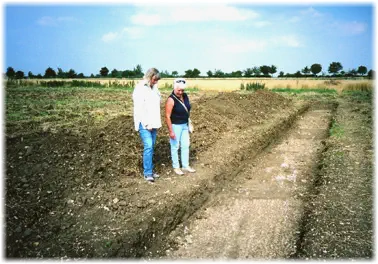
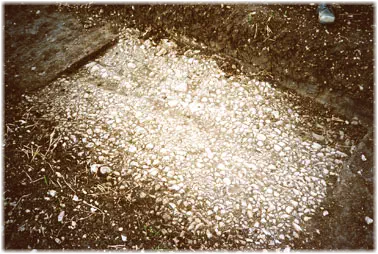
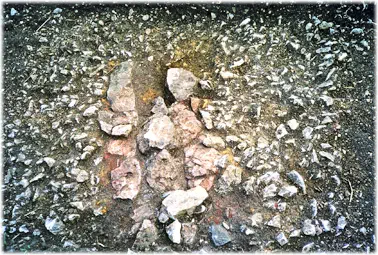
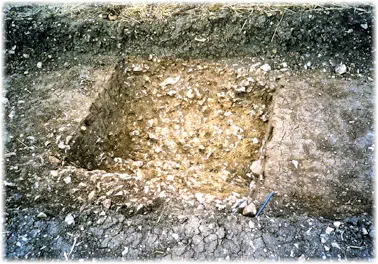
Rut marks in the surface of the Romano-British road at Thistleton
The Romano-British infilled ditch found on the Thistleton site. The skeleton of a small child was found near here
Burnt limestone indicates a hearth surrounded by flooring material
The Romano-British infilled ditch found on the Thistleton site. The skeleton of a small child was found near here

Researching Rutland
Copyright © Rutland Local History and Record Society - All rights reserved
Registered Charity No 700273
Menu

Rutland Local History & Record Society

Copyright © Rutland Local History and Record Society
Registered Charity No 700273
Rutland History Society's Archaeological
Group has been fieldwalking an area near
Thistleton for several years. It is known to
have been the site of a Romano-British
town, but most of it was thought to have
been lost as a result of ironstone
quarrying in the 1950s. However, the
investigation revealed that the
archaeology had survived and that the town extended to nearly 100 acres. This
confirmed the need for the more intensive survey which followed. Jeremy
Taylor of Leicester University, assisted by members of the group, then carried
out a geophysical survey which revealed a number of interesting features
including a magnificent temple, roads, ditches and iron smelting sites.
When a planning application was presented
to open a new limestone quarry in the area a
condition attached to the permission stated
that a haulage road had to be built in order to
avoid disruption and noise to the village.
The route chosen happened to go through
the site of the Romano-British town. A known
or suspected site of archaeological
significance must be evaluated before work
commences. In this case an extensive
geophysical survey and trial trenching was carried out along the length of the
proposed road by Northamptonshire Archaeology.
The results were spectacular. A section of
exceptionally well preserved Roman road was
exposed, the rut marks from wheels still clearly
visible. In another trench an oven was found,
the stones showing clear signs of burning and
there was evidence of a possible flue structure.
Several ditches were uncovered and collapsed
masonry pointed to where walls had once
stood. The skeleton of a child was perhaps the most remarkable find. It was a
considerable distance from a cemetery which had been excavated by Ernest
Greenfield in the late 1950s.
Before the arrival of Christianity, it was
not uncommon for young children to be
buried with little or no ceremony and in
places that we would find very strange
today, even under the floors of houses.
One of several theories suggests that
until a child could speak properly it was
not considered to be fully human.
Geophysics and trial trenching were also undertaken on the site of the quarry
itself. Whilst not quite so exciting as the finds along the haulage road there was
nonetheless evidence of Romano-British rural activity together with an undated
ring ditch. When work begins to open the quarry a watching brief will take place.
This will involve archaeologists observing the topsoil as it is removed. It is highly
likely that more archaeology will be found.
All the trenches were accurately recorded and photographed before back
filling. None of the structures found were lifted, although pottery sherds were
removed for dating purposes. If the haulage road is built the archaeology will be
protected for future generations by a special membrane, which acts as a shock
absorber, and approximately 1.5 metres of earth.
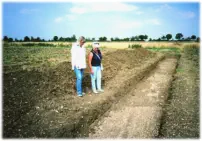
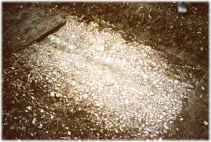
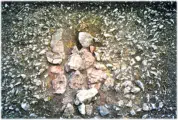
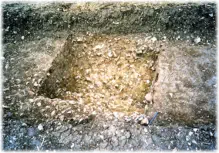
Rut marks in the surface of the Romano-British road at Thistleton
Burnt limestone indicates a hearth surrounded by
flooring material
The Romano-British infilled ditch found on the Thistleton site.
The skeleton of a small child was found near here
Thistleton Secrets Revealed
Inspecting the Romano-British road at Thistleton.
The line of trees marks Fosse Lane, a link between
Ermine Street and Fosse Way





